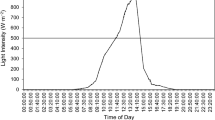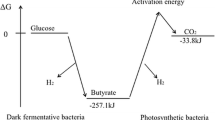Abstract
Fluorescent and incandescent lighting systems were applied for batch photofermentative hydrogen production by four purple non-sulfur photosynthetic bacteria (PNSB). The hydrogen production efficiency of Rhodopseudomonas palustris, Rhodobacter sphaeroides, Rhodobacter capsulatus, and Rhodospirillum rubrum was evaluated using different carbon sources (acetate, butyrate, lactate, and malate). Incandescent light was found to be more effective for bacteria cell growth and hydrogen production. It was observed that PNSB followed substrate selection criteria for hydrogen production. Only R. palustris was able to produce hydrogen using most carbon sources. Cell density was almost constant, but cell growth rate and hydrogen production were significantly varied under the different lighting systems. The kinetics study suggested that initial substrate concentration had a positive correlation with lag phase duration. Among the PNSB, R. palustris grew faster and had higher hydrogen yields of 1.58, 4.92, and 2.57 mol H2/mol using acetate, butyrate, and lactate, respectively. In the integrative approach with dark fermentation effluents rich in organic acids, R. palustris should be enriched in the phototrophic microbial consortium of the continuous hydrogen production system.




Similar content being viewed by others
References
Logan, B. E. (2004). Extracting hydrogen and electricity from renewable resources. Environmental Science and Technology., 38(9), 160A–167A.
Hallenbeck, P. C., & Liu, Y. (2016). Recent advances in hydrogen production by photosynthetic bacteria. International Journal of Hydrogen Energy, 41(7), 4446–4454.
Yilmaz, F., Balta, M. T., & Selbaş, R. (2016). A review of solar based hydrogen production methods. Renewable and Sustainable Energy Reviews, 56, 171–178.
Sinha, P., & Pandey, A. (2011). An evaluative report and challenges for fermentative biohydrogen production. International Journal of Hydrogen Energy, 36(13), 7460–7478.
Lin, C. N., Wu, S. Y., Lee, K. S., Lin, P. J., Lin, C. Y., & Chang, J. S. (2007). Integration of fermentative hydrogen process and fuel cell for on-line electricity generation. International Journal of Hydrogen Energy, 32, 802–808.
Keskin, T., Abo-Hashesh, M., & Hallenbeck, P. C. (2011). Photofermentative hydrogen production from wastes. Bioresource Technology, 102(18), 8557–8568.
Ghosh, S., Dairkee, U. K., Chowdhury, R., & Bhattacharya, P. (2017). Hydrogen from food processing wastes via photofermentation using purple non-sulfur bacteria (PNSB)–a review. Energy Conversion and Management, 141, 299–314.
Kim, D. H., Son, H., & Kim, M. S. (2012). Effect of substrate concentration on continuous photo-fermentative hydrogen production from lactate using Rhodobacter sphaeroides. International Journal of Hydrogen Energy, 37(20), 15483–15488.
Dadak, A., Aghbashlo, M., Tabatabaei, M., Younesi, H., & Najafpour, G. (2016). Exergy-based sustainability assessment of continuous photobiological hydrogen production using anaerobic bacterium Rhodospirillum rubrum. Journal of Cleaner Production, 139, 157–166.
Brenner, D.J., Boone, D.R., Garrity, G.M., Goodfellow, M., Krieg, N.R., Rainey, F.A., Schleifer, K.H., Staley, J.T., and Vos, P. (2005) Bergey’s manual of systematic bacteriology. 2nd ed., USA.
Ren, N. Q., Liu, B. F., Ding, J., & Xie, G. J. (2009). Hydrogen production with R. faecalis RLD-53 isolated from freshwater pond sludge. Bioresource Technology, 100(1), 484–487.
Sasikala, K., Ramana, C. V., & Raghuveer Rao, P. (1992). Photoproduction of hydrogen from the waste water of a distillery by Rhodobacter sphaeroides O.U. 001. International Journal of Hydrogen Energy, 17(1), 23–27.
Zhang, D., Xiao, N., Mahbubani, K. T., del Rio-Chanona, E. A., Slater, N. K. H., & Vassiliadis, V. S. (2015). Bioprocess modelling of biohydrogen production by Rhodopseudomonas palustris: model development and effects of operating conditions on hydrogen yield and glycerol conversion efficiency. Chemical Engineering Science, 130, 68–78.
Ozmihci, S., & Kargi, F. (2010). Comparison of different mixed cultures for bio-hydrogen production from ground wheat starch by combined dark and light fermentation. Journal of Industrial Microbiology and Biotechnology, 37(4), 341–347.
Argun, H., & Kargi, F. (2010). Effects of light source, intensity and lighting regime on bio-hydrogen production from ground wheat starch by combined dark and photo-fermentations. International Journal of Hydrogen Energy, 35(4), 1604–1612.
Muzziotti, D., Adessi, A., Faraloni, C., Torzillo, G., & De Philippis, R. (2016). H2 production in Rhodopseudomonas palustris as a way to cope with high light intensities. Research in Microbiology, 167(5), 350–356.
Corona, V. M., Le Borgne, S., Revah, S., & Morales, M. (2017). Effect of light-dark cycles on hydrogen and poly-β-hydroxybutyrate production by a photoheterotrophic culture and Rhodobacter capsulatus using a dark fermentation effluent as substrate. Bioresource Technology, 226, 238–246.
Boran, E., Özgür, E., Gebicki, J., van der Burg, J., Yücel, M., Gündüz, U., Modigel, M., & Eroglu, I. (2009). Investigation of influencing factors for biological hydrogen production by R. capsulatus in tubular photo-bioreactors. Chemical Engineering Transactions, 18, 357–362.
Hu, C., Giannis, A., Chen, C. L., & Wang, J. Y. (2014). Evaluation of hydrogen producing cultures using pretreated food waste. International Journal of Hydrogen Energy, 39(33), 19337–19342.
Hay, J. X. W., Wu, T. Y., & Juan, J. C. (2013). Biohydrogen production through photo fermentation or dark fermentation using waste as a substrate: overview, economics, and future prospects of hydrogen usage. Biofuels, Byproducts and Biorefining, 7(3), 334–352.
Trchounian, A. (2015). Mechanisms for hydrogen production by different bacteria during mixed-acid and photo-fermentation and perspectives of hydrogen production biotechnology. Critical Reviews in Biotechnology, 35(1), 103–113.
Gardini, F., Martuscelli, M., Caruso, M. C., Galgano, F., Crudele, M. A., Favati, F., Guerzoni, M. E., & Suzzi, G. (2001). Effects of pH, temperature and NaCl concentration on the growth kinetics, proteolytic activity and biogenic amine production of Enterococcus faecalis. International Journal of Food Microbiology, 64(1), 105–117.
Xie, G. J., Liu, B. F., Xing, D. F., Ding, J., Nan, J., Ren, H. Y., Guo, W. Q., & Ren, N. Q. (2012). The kinetic characterization of photofermentative bacterium Rhodopseudomonas faecalis RLD-53 and its application for enhancing continuous hydrogen production. International Journal of Hydrogen Energy, 37(18), 13718–13724.
Lo, Y. C., Chen, W. M., Hung, C. H., Chen, S. D., & Chang, J. S. (2008). Dark H2 fermentation from sucrose and xylose using H2-producing indigenous bacteria: feasibility and kinetic studies. Water Research, 42(4), 827–842.
Uyar, B. (2013). A novel non-invasive digital imaging method for continuous biomass monitoring and cell distribution mapping in photobioreactors. Journal of Chemical Technology and Biotechnology, 88(6), 1144–1149.
Lazaro, C. Z., Varesche, M. B. A., & Silva, E. L. (2015). Effect of inoculum concentration, pH, light intensity and lighting regime on hydrogen production by phototrophic microbial consortium. Renewable Energy, 75, 1–7.
McKinlay, J. B., & Harwood, C. S. (2011). Calvin cycle flux, pathway constraints, and substrate oxidation state together determine the H2 biofuel yield in photoheterotrophic bacteria. MBio, 2(2), e00323–e00310.
Koku, H., Eroğlu, I., Gündüz, U., Yücel, M., & Türker, L. (2002). Aspects of the metabolism of hydrogen production by Rhodobacter sphaeroides. International Journal of Hydrogen Energy, 27(11), 1315–1329.
Tao, Y., He, Y., Wu, Y., Liu, F., Li, X., Zong, W., & Zhou, Z. (2008). Characteristics of a new photosynthetic bacterial strain for hydrogen production and its application in wastewater treatment. International Journal of Hydrogen Energy, 33(3), 963–973.
Kars, G., & Gündüz, U. (2010). Towards a super H2 producer: improvements in photofermentative biohydrogen production by genetic manipulations. International Journal of Hydrogen Energy, 35(13), 6646–6656.
Author information
Authors and Affiliations
Corresponding author
Ethics declarations
Conflict of Interest
The authors declare that they have no conflict of interest.
Rights and permissions
About this article
Cite this article
Hu, C., Choy, SY. & Giannis, A. Evaluation of Lighting Systems, Carbon Sources, and Bacteria Cultures on Photofermentative Hydrogen Production. Appl Biochem Biotechnol 185, 257–269 (2018). https://doi.org/10.1007/s12010-017-2655-5
Received:
Accepted:
Published:
Issue Date:
DOI: https://doi.org/10.1007/s12010-017-2655-5




